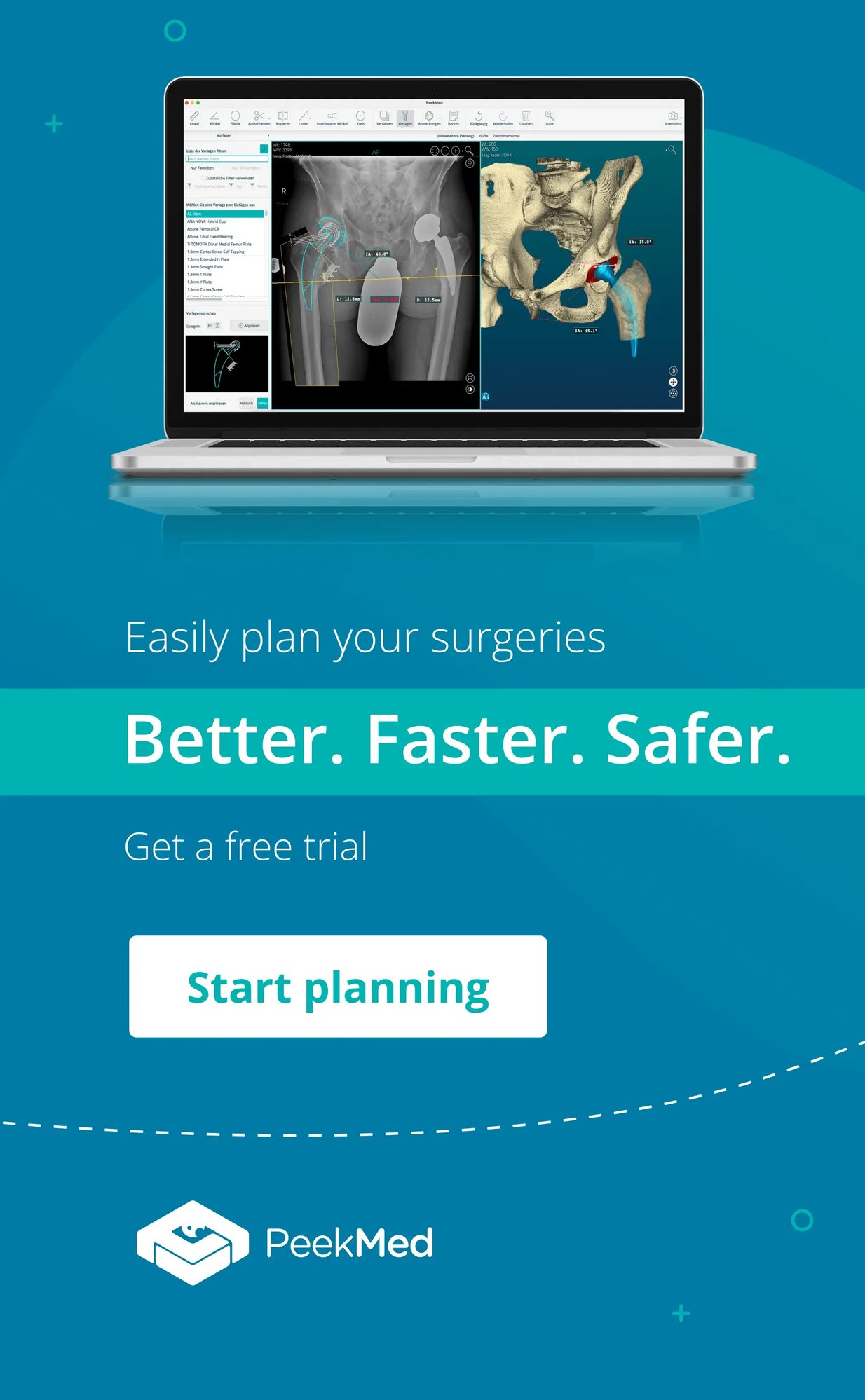PeekMed
In 2021, the OECD averages were 174 per 100 000 population for hip replacement, and 137 per 100 000 for knee replacement, much due to osteoarthritis.
Before the orthopedic surgery starts, it is important that the chosen implants fit the patient well and it does not lead to any complications, like pain or unequal leg length. 3D visualization technology can aid in this quest of improving the performance of pre-operative planning and, consequent, surgery.
What is 3D Visualization?
In general, 3D Visualization defines as the process of creating 3D graphics images that resemble reality by using 3D software. Within the context of orthopedics, it is the process of creating 3D models generated by image segmentation from the medical image of a patient.
Pre-operative planning is the most important step in predicting and preventing complications. The conventional method to plan a surgery, such as THR, has been to use hard copies of X-ray images and printed templates for implants to find out which implant to use. This method can lead to many misunderstandings in measurements and the planning of more complex surgeries.
Luckily, the veracity of using 3D templates in planning has been studied. A study made by Reinbacher et al. in 2022 compared the accuracy of digital planning using 2D versus 3D templating in THA and found that 3D templating showed significantly higher accuracy than 2D templating in terms of cup size and stem size.
Templating in orthopedics is the process where surgeons use templates to estimate the correct size of the implant to be used in surgery. Templating can help predict implants to be within one size, decrease the risk of periprosthetic fracture and dislocation, and assist surgeons to plan the position and depth of insertion.
It is a huge advantage to use 3D bone models since it allows stereoscopic vision, providing more information for the surgeon. The 3D imaging allows a more precise choice for the implant size turning the visualization of anatomical structures easier, regardless of the patients’ slight body movements during the scanning process.
If we consider this, it is valuable that the orthopedic templating software is able to generate 3D bone reconstructions from 2D X-rays. A PeekMed study achieved high accuracy, reliability, and repeatability for converting 2D radiographs to 3D bone reconstructions similar to a CT scan. These findings mean a reduction in cost, time, and radiation exposure while benefiting from the 3D gains.
From this, 3D visualization for surgery opens the door to many possibilities, for example, 3D printing and augmented reality.
Medical 3D printing
Medicine overall is advancing towards ‘mass customization’ with orthopedics being one of the fields that benefits more from 3D printing as it uses more implants and deals less with soft tissue and organs.
One of the main benefits of 3D visualization and printing within orthopedics is the creation of custom 3D printed medical implants. 3D images of bones can be generated in a 3D medical imaging software to help plan for an implant and then a 3D anatomical model of that implant can be printed through a 3D printer.
To improve the success of the surgery, surgeons are increasingly using patient-specific single-use 3D printed instruments that allow the implants to be inserted more precisely.
3D printing is also advantageous for planning through the use of 3D printed patient-specific surgical guide plates in orthopedic surgery. These guide plates allow the surgeon to study where and how they will insert the implant and they can even be used during the surgery for extra guidance.
Some surgeons use them as a way to practice the procedure beforehand so they are more ready during the actual one. It can also help in the manufacturing of the implant in cases of degeneration by comparing the printed bones with the patient’s bones.
3D printing for surgical planning is also becoming crucial to improve communication with the patient. The patient can better comprehend complex concepts related to the procedure itself and its benefits. With this, they will be more comfortable with the surgery and be more likely to follow through on the post-surgical instructions.
This comprehension of complex concepts through 3D printed models also applies to the medical training of future surgeons.
Augmented reality (AR) for orthopedic surgery
3D visualization and augmented reality for orthopedics are gaining popularity and traction for good reasons.
Augmented reality-assisted surgery (ARAS) uses technology that lays over a computerized image on a surgeon’s view of the operative area. This way, the surgeon doesn’t need to look away from the patient to collect and process information (e.g. exams, vital signals, surgery planning) while performing critical surgeries.
AR connected with 3D visualization mitigates errors since the procedures can be simulated multiple times with nearly 100% accuracy. This simulation allows the surgery to proceed with minimum incisions which results in less pain, faster recovery, and reduced post-operative complications.
Another gain is through the camera augmented c-arm that can remotely do surgery with the aid of AR. Here, the surgeon relies on the camera and some sensory input, but with AR the surgeon can see better and be more precise.
Similar to 3D Print, 3D augmented reality in orthopedics also aids communication with the patient through animated videos that can easily and more thoroughly explain the procedures. These 3D animations can be used to show details that are hard for patients to see. These are also very efficient for medical training.
Is 3D visualization the future?
3D visualization and planning within an orthopedic software have the potential for improving the performance of orthopedic surgeries.
One of the biggest challenges for the future still relies on making the interactions as intuitive as they are in 2D, as people working in the medical field have a long history of working in 2D and may not be as familiar with 3D.
However, that is part of human evolution and we believe that, with 3D planning orthopedics, we can make the world change towards a bright future and have better medical conditions for all.



.png?width=2400&height=1200&name=DICOM%20Infograph%20(1).png)
.png?width=2400&height=1200&name=DICOM%20Infograph%20(2).png)

